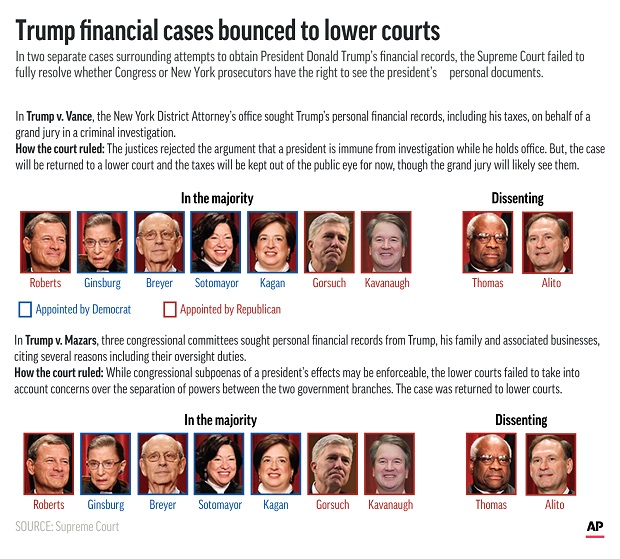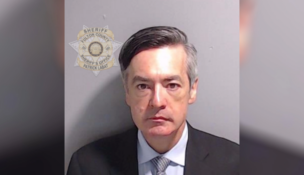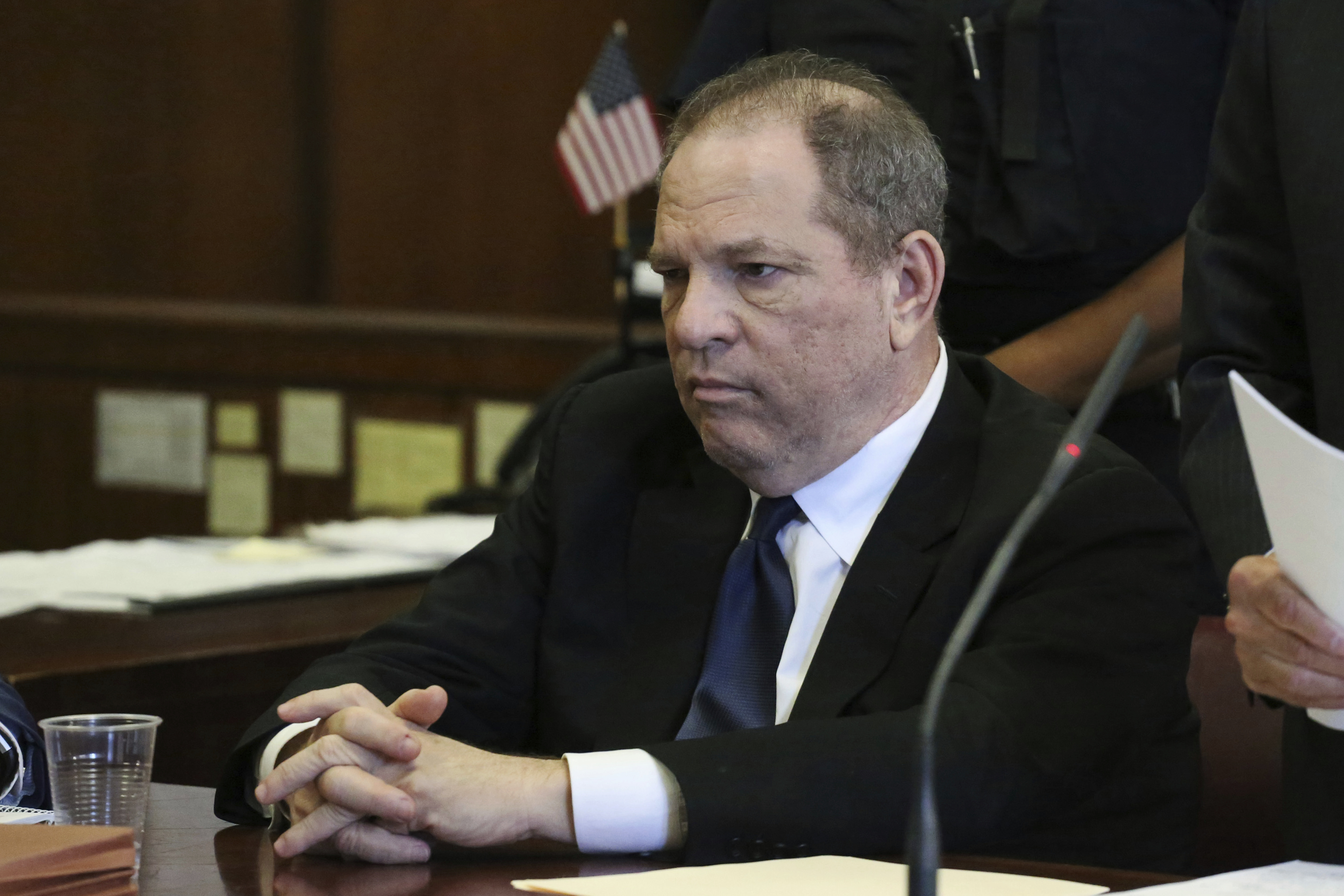Thomas spoke, Roberts ruled in unusual US Supreme Court term
By: Associated Press//July 10, 2020//
By MARK SHERMAN and JESSICA GRESKO
Associated Press
WASHINGTON (AP) — Justice Clarence Thomas spoke and Chief Justice John Roberts ruled.
The Supreme Court’s most unusual term featured victories for undocumented immigrants, abortion rights, LGBTQ workers and religious freedoms. The usually quiet Thomas’ baritone was heard by the whole world when the coronavirus outbreak upended the court’s standard way of doing business. When the biggest decisions were handed down, the chief justice was almost always in the majority and dictated the reach of the court’s most controversial cases, whether they were won by the left or the right.
The decisions in some of the biggest cases came with majorities of six or seven justices, a blurring of the stark 5-4 divide between conservatives and liberals on the court that Roberts and his colleagues have worried would cast them as mere politicians in black robes.
“The outcomes attest to the justices’ understanding that their legitimacy rests upon not deciding cases on the deeply partisan lines that everybody else seems to use in society,” said David Cole, the legal director of the American Civil Liberties Union.
The rulings may make it difficult for President Donald Trump to claim complete success to his base over his 2016 promise to swing the court solidly to the right as he campaigns for reelection under a worsening pandemic, historic unemployment and mass protests over racial inequality.
Still it may give him the opportunity to ask voters for even more than the 200 Trump-appointed judges on federal courts, including Justices Neil Gorsuch and Brett Kavanaugh.
“Do you get the impression that the Supreme Court doesn’t like me?” he tweeted after the court ruled against him in a major immigration case. What the court needs, he said, is more conservative justices: “Vote Trump 2020!”
Roberts and Gorsuch, who wrote the opinion that said firing someone based on their sexual orientation or gender identity is illegal, were part of majorities that otherwise included liberal justices. And some of the liberal justices joined with conservatives in a defeat for environmental interests and in two religious liberty cases, including one that prohibits some employees of religious schools from suing over job discrimination.
“The court really is doing this delicate dance, giving progressives some real victories,” said Adam White, a law professor at George Mason University’s law school, citing the LGBTQ case. At the same time, he said, the court is moving forward on some of the religious liberty cases.
“It’s fascinating to watch those two things move on parallel tracks.”
When the court in its last opinions of the term Thursday rejected Trump’s claims of immunity from congressional and criminal investigations, while also making it all but certain that Trump’s financial records won’t become public before the November election, a broad coalition of justices that included Kavanaugh and Gorsuch joined in the majority.
___
No one proved more influential in negotiating a term crammed with controversial cases than Roberts, the 65-year-old chief justice who has led the court for nearly 15 years. He wrote the court’s opinion preserving protections for hundreds of thousands of immigrants who were brought to the U.S. as children. Roberts also had both majority opinions in the cases about Trump’s financial records.
He also spoke for the court in requiring states to include religious schools when they direct public money to private schools. And Roberts had the decisive opinion that struck down a Louisiana abortion law, but may also have given abortion opponents a road map they can use to win future abortion cases.
By contrast, Roberts was a dissenting vote in just two of the court’s nearly 60 cases, and wrote just one dissenting opinion. And nearly forgotten in recent months during the virus-related shutdown, Roberts presided over Trump’s Senate impeachment trial, declining to play an outsized role as majority Republicans acquitted the president of charges he abused his power and obstructed Congress.
“The fact that Roberts is now sometimes a ‘swing’ vote on this Court only shows how conservative the Court as a whole really is,” Elizabeth Wydra, president of the liberal Constitutional Accountability Center, said in a written statement.
The term variously pleased and infuriated liberals and conservatives.
The ACLU’s Cole called it “a surprisingly good term from the standpoint of civil rights and civil liberties,” though the ACLU also represented an asylum-seeking Sri Lankan man who lost his high-court bid. Conservative commentator Carrie Severino criticized Roberts for what she said “looks like a troubling pattern of him being motivated by politics rather than by legal reasoning.” But Severino also noted the court’s “impressive” decisions in religious liberty cases.
___
How much did the coronavirus outbreak change things at the Supreme Court? The court met by telephone for the first time, Thomas broke his usual silence at arguments, and the whole world could listen, even hearing what sounded like a toilet flush during arguments. And for the first time in nearly a quarter century, the justices kept churning out opinions into July.
They didn’t meet in person or set foot in the courtroom after early March because of the pandemic. When they delivered the biggest decisions of the term in June and July, it was all done electronically.
Still, the opinions, especially dissenting views crackling with anger and frustration, gave readers a window into emotions behind the decisions. Conservative Justice Samuel Alito, in the LGBTQ case, accused his colleagues of overstepping their role, writing: “There is only one word for what the Court has done today: legislation.”
On the other side of the court, liberal Justice Sonia Sotomayor, said her colleagues had skewed the facts and taken a “simplistic” approach in a case she said would strip thousands of schoolteachers of employment discrimination protection.
___
The term also included three hospital stays, and not all of those involved 87-year-old Justice Ruth Bader Ginsburg, the court’s oldest justice. Roberts spent a night in the hospital after a Father’s Day fall in which he injured his forehead, the court said in belatedly confirming the hospital stay more than two weeks later.
Ginsburg, who has battled cancer four times, was in the hospital twice for infections, including in May when she took part in arguments from a hospital room.
There was speculation during the last weeks of the term that either Alito, 70, or Thomas, 72, could retire in the hope of giving Trump a third Supreme Court appointment and putting a like-minded and younger jurist on the bench.
But there hasn’t been an election-year retirement in more than 50 years, and, as of now, that hasn’t changed.
Legal News
- Chesebro among those charged with interfering in 2020 election
- Williams-Sonoma must pay almost $3.2 million for violating FTC’s ‘Made in USA’ order
- Harvey Weinstein due back in court, while a key witness weighs whether to testify at a retrial
- Protests erupt on college campuses throughout Midwest, and U.S. over war in Gaza
- Flight attendant indicted in attempt to record girl in airplane bathroom
- Wisconsin attorney loses law license, ordered to pay $16K fine
- Former Wisconsin police officer charged with 5 bestiality felony counts
- Judge reject’s Trump’s bid for a new trial in $83.3 million E. Jean Carroll defamation case
- Dozens of deaths reveal risks of injecting sedatives into people restrained by police
- The Latest: Supreme Court arguments conclude in Trump immunity case
- Net neutrality restored as FCC votes to regulate internet providers
- Wisconsin Attorney General asks Congress to expand reproductive health services
WLJ People
- Power 30 Personal Injury Attorneys – Russell Nicolet
- Power 30 Personal Injury Attorneys – Benjamin Nicolet
- Power 30 Personal Injury Attorneys – Dustin T. Woehl
- Power 30 Personal Injury Attorneys – Katherine Metzger
- Power 30 Personal Injury Attorneys – Joseph Ryan
- Power 30 Personal Injury Attorneys – James M. Ryan
- Power 30 Personal Injury Attorneys – Dana Wachs
- Power 30 Personal Injury Attorneys – Mark L. Thomsen
- Power 30 Personal Injury Attorneys – Matthew Lein
- Power 30 Personal Injury Attorneys – Jeffrey A. Pitman
- Power 30 Personal Injury Attorneys – William Pemberton
- Power 30 Personal Injury Attorneys – Howard S. Sicula












